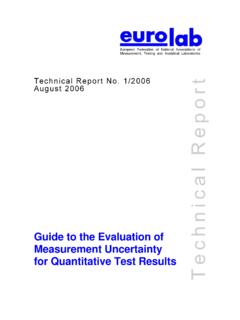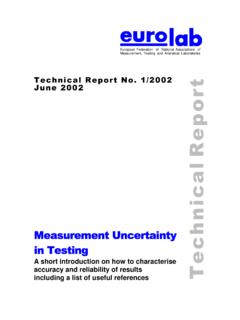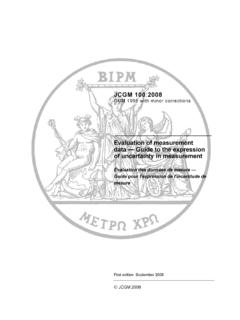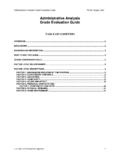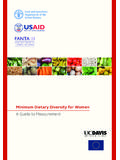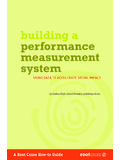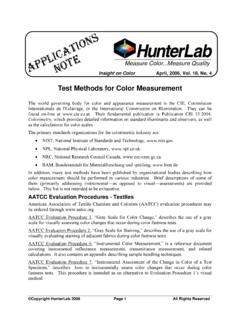Transcription of l a c i n Guide to the Evaluation of h Measurement ...
1 European Federation of National Associations of Measurement , Testing and Analytical Laboratories Technical Report No. 1/2006 August 2006 Guide to the Evaluation of Measurement Uncertainty for Quantitative Test Results T e c h n i c a l R e p o r t 2 / 50 Guide to the Evaluation of Measurement Uncertainty for Quantitative Test Results Impressum EUROLAB Technical Report 1/2006 Guide to the Evaluation of Measurement Uncertainty for Quantitative Test Results August 2006 EUROLAB Technical Secretariat - EUROLAB 1 rue Gaston Boissier 75724 PARIS Cedex 15 FRANCE Phone: +33 1 40 43 39 45 Fax: +33 1 40 43 37 37 e-Mail: URL: EUROLAB Technical Report 1/2006 Guide to the Evaluation of Measurement Uncertainty for Quantitative Test Results 3 / 50 Guide to the Evaluation of Measurement Uncertainty for Quantitative Test Results Editorial note This document is based on the BAM-Leitfaden zur Ermittlung von Messunsicherheiten bei quantitativen Pr fergebnissen published by the Federal Institute for Materials Research and Testing (BAM), Germany [Forschungsbericht 266, 2004], which was jointly agreed by BAM and the EUROLAB Board of Administrators to be translated into English and published as a EUROLAB Technical Report.
2 The original document was prepared on behalf of the BAM Quality Management Committee (AQM) as a technical guidance document supporting the BAM Directive for estimation and specification of the uncertainty of test results. Author: Werner H sselbarth Contributions: Manfred Golze, Siegfried Noack, Andreas Subaric-Leitis Translation: Nigel Pye Editing: Werner H sselbarth and Manfred Golze Comments are acknowledged from Bertil Magnusson (SP, Sweden), Pascal Launey (LNE, France) on behalf of the Measurement uncertainty expert group of EUROLAB-France, and Vitor Ramos (RELACRE, Portugal). The draft technical report was approved by the EUROLAB Technical Committee for Quality Assurance in Testing (TCQA) at its meeting on 8 May 2006 and by the EUROLAB General Assembly in Bor s, Sweden, on 16 May 2006.
3 4 / 50 Guide to the Evaluation of Measurement Uncertainty for Quantitative Test Results EUROLAB Technical Report 1/2006 Guide to the Evaluation of Measurement Uncertainty for Quantitative Test Results 5 / 50 Contents Foreword .. 7 1 Definitions .. 8 Terms of Measurement Uncertainty .. 8 Terms of Test Accuracy .. 9 2 10 Basic Metrological Terms and 10 Accuracy, Trueness and Precision; Target 13 New Aspects in " Guide to the Expression of Uncertainty in Measurement .. 14 New Definition of Measurement 14 Determining Type A and Type B Uncertainty Components .. 15 Equal Treatment of All Uncertainty Components .. 16 Expanded Uncertainty.
4 16 Worst-case Estimation of Measurement Uncertainty ..17 3 Analytical-Computational Determination of Measurement 17 Overview .. 17 Classification of Measurement Uncertainty According to Evaluation 18 General Method for Determination of Uncertainty .. 19 Instructions on the Use of Uncertainty Budgets .. 23 Worst-case Estimation .. 24 4 Estimation of Measurement Uncertainties using Within-laboratory Validation and Quality Control 25 General .. 25 One-Point 25 Investigation of Precision .. 26 Investigation of 27 Dealing with Observed 27 N-Point Protocol (N 2).. 29 Interpolation .. 29 Least Squares 30 5 Estimation of Measurement Uncertainties using Inter-laboratory 31 Inter-laboratory Comparisons for Method Validation.
5 31 Inter-laboratory Comparisons for Proficiency Testing .. 32 Inter-laboratory Comparisons for Reference Material Certification .. 33 6 Hybrid Strategies for Evaluation of Measurement 34 7 Specification and Documentation of Measurement 35 35 36 Frequently Occurring Sources of Uncertainty .. 36 Uncertainty in Linear Calibration .. 37 General .. 37 Determination of Intercept and Slope ..38 Evaluating the Uncertainty of Intercept and 39 Modelling of Process Steps by Efficiencies and Increments .. 41 Numerical Methods for Uncertainty Propagation .. 43 Finite Difference 43 Monte Carlo Simulation .. 44 Software.
6 44 Uncertainty of Mean Values .. 45 General .. 45 Correlation within a Measurement Evaluation of Covariances and Correlation 47 General .. 47 Uncertainty Propagation .. 48 Parallel 48 Correlation Coefficients .. 49 6 / 50 Guide to the Evaluation of Measurement Uncertainty for Quantitative Test Results EUROLAB Technical Report 1/2006 Guide to the Evaluation of Measurement Uncertainty for Quantitative Test Results 7 / 50 Foreword After more than ten years since the first arrival of Measurement uncertainty in the EUROLAB community (where the GUM was presented at the Eurolab Symposium in Florence 1994), Evaluation of Measurement uncertainty for test results is still an issue of major concern not in principle but in daily practice.
7 Concerning principal issues, the Guide to the Expression of Uncertainty in Measurement , known as the GUM, is acknowledged as the master document on Measurement uncertainty throughout testing. The term Measurement uncertainty is recognised to apply to all types of quantitative test results, and the GUM principles are fully accepted. However, when it comes to evaluating the uncertainty of the results for a (quantitative) test procedure, the GUM is often criticised to be inapplicable. This impression is due to the fact that the GUM almost exclusively treats a single approach for uncertainty Evaluation : the modelling approach based on a comprehensive mathematical model of the Measurement procedure, where every uncertainty contribution is associated with a dedicated input quantity, the uncertainty contributions are evaluated individually and combined as a root sum of squares.
8 This is therefore often (mis)conceived as being the GUM approach for uncertainty Evaluation . Actually the GUM principles admit a variety of approaches, but this fact was buried under a plethora of papers and lectures celebrating the modelling approach as a new paradigm in Measurement quality assurance. Only recently alternative empirical approaches received greater attention. They are based on whole-method performance investigations designed and conducted as to comprise the effects from as many relevant uncertainty sources as possible. The data utilised in these approaches are typically precision and bias data obtained from within-laboratory validation studies, quality control, interlaboratory method validation studies, or proficiency tests.
9 Such approaches are fully compliant with the GUM, provided that the GUM principles are observed. Eurolab has consistently advocated the use of empirical approaches as a valid, and often more practical alternative to the modelling approach, by publication of Technical Reports on Measurement uncertainty in testing. The first in this series (No. 1/2002) is an introductory text for newcomers. This is now supplemented by a comprehensive technical Guide for more experienced users. It provides a survey both of the modelling or bottom-up approach, which presupposes a complete mathematical model of the Measurement process, and empirical or top-down approaches based on whole-method performance data.
10 A further Eurolab TR under development by a dedicated expert group will deal with comparison and combination of uncertainty estimates obtained from the major approaches currently available. That report will include a collection of examples from different testing fields, where the results obtained using different approaches are compared, and the conclusions drawn from the comparison are discussed. 8 / 50 Guide to the Evaluation of Measurement Uncertainty for Quantitative Test Results Guide to the Evaluation of Measurement Uncertainty for Quantitative Test Results This document offers techical guidance on the Evaluation of Measurement uncertainty for quantitative test results. While fully compliant with the principles of the Guide to the Expression of Uncertainty in Measurement (GUM), the document also includes alternative approaches to the bottom-up approach, based on a comprehensive mathematical model of the Measurement process, as emphasized in the GUM.
